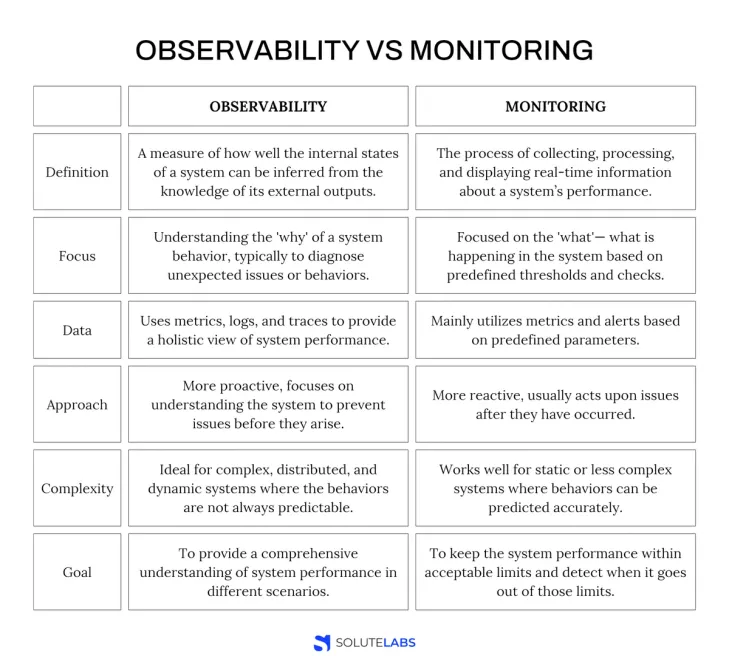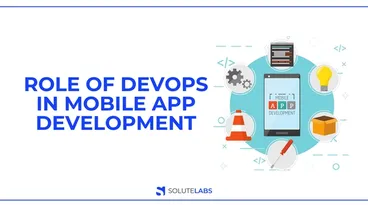DevOps observability has become a game-changer in the world of software development. With its ability to provide real-time insights into complex systems, it offers teams the opportunity to detect and resolve issues quickly, optimize performance, and achieve continuous improvement. In this blog post, we will explore the concept of DevOps observability and guide you through its implementation, empowering you to enhance your software delivery practices effectively.
What is Observability in DevOps?
Observability in DevOps is an approach that allows you to comprehensively view and understand the state of your system, even in the face of unforeseen issues or events. It’s not just about whether a system is functional or not, but understanding how it is functioning and why.
It's about having a holistic understanding of your infrastructure, applications, and log data, and being able to make sense of it all in real-time. This is typically achieved through three key pillars: metrics, logs, and traces, often abbreviated as the "golden signals" of observability.
Also, Read: How to Assess Your Organization's Readiness for DevOps Implementation?
The Importance of Observability in DevOps
As we delve deeper into the digital age, system complexities are on the rise, as are customer expectations. In such an environment, DevOps observability becomes a critical aspect of efficient software delivery and operations.
1. Faster Problem Solving:
A robust observability setup allows DevOps teams to identify, understand, and rectify issues quickly. When a problem arises, the extensive data from metrics, logs, and traces can help pinpoint the exact cause, reducing the Mean-Time-To-Resolution (MTTR).
2. Proactive Incident Management:
Observability enables teams to notice trends and patterns, allowing them to predict and prevent potential issues before they affect end users. This proactive approach to incident management can significantly improve system uptime and reliability.
3. Optimized Performance:
With observability, teams can gain insights into how changes impact the system's performance. This helps in making informed decisions about system optimization, load balancing, and resource allocation.
4. Increased Understanding of System Behavior:
Observability provides a clear view of how different components interact with each other. This is particularly important in modern, distributed systems, where understanding system behavior can be complex.
5. Improved Customer Experience:
Ultimately, all the above benefits contribute to an improved customer experience. With fewer downtimes, quicker issue resolution, and optimized performance, end-users enjoy a smoother, more reliable service.
Observability vs Monitoring: What are the Differences
Also, Read: Top 21 DevOps Monitoring Tools To Use in 2023
How to Implement DevOps Observability
Implementing DevOps Observability is not a one-size-fits-all process, as it will depend on your specific system and business needs. However, there are certain key steps that can guide you toward an effective and efficient observability strategy.
1. Define Your Key Performance Indicators (KPIs)
Before you can observe anything, you need to know what you're looking for. Identify the key performance indicators for your system. These could be things like response times, error rates, throughput, or CPU usage. Having clear KPIs helps you understand what normal performance looks like, making it easier to spot anomalies or issues.
2. Leverage the Three Pillars of Observability
Observability relies heavily on metrics, logs, and traces - often referred to as the three pillars of observability. Make sure your system can produce these three types of data.
Metrics:
Implement a metrics collection system that can track important performance metrics over time. Tools like Prometheus, Datadog, or New Relic can be useful for this.
Logs:
Ensure that your applications and infrastructure are set up to log important events. Consider using a centralized logging solution like ELK Stack (Elasticsearch, Logstash, Kibana) or Splunk for easier log management.
Traces:
For distributed systems, distributed tracing tools like Jaeger or Zipkin can help visualize the path of requests through your services.
3. Instrument Your Code
To gather detailed information about how your software is behaving, you'll need to instrument your code. This involves adding code to your application to collect performance data, log important events, and trace requests.
4. Choose the Right Observability Tools
The market is saturated with a variety of observability tools. Your choice will depend on various factors such as your technology stack, team's skills, budget, and specific needs. Some tools cover all three pillars of observability, such as Elastic Stack or Dynatrace, while others focus on specific areas.
5. Adopt a Culture of Observability
Tools and technologies can only go so far. To truly reap the benefits of DevOps Observability, it's crucial to foster a culture of observability within your team. Encourage a proactive approach to problem-solving, and promote the habit of continuously monitoring and learning from your system's performance data.
6. Continuously Improve and Adapt
The process of implementing observability doesn't stop once you've set everything up. It's important to continuously review and adapt your observability practices to align with evolving business needs and system changes. Regularly assess your KPIs, improve your data collection methods, and upgrade or switch your tools as necessary.
Implementing DevOps Observability can seem like a daunting task, but the payoff in improved system reliability, efficiency, and user satisfaction makes it worth the effort. Remember, it's not about having a perfect observability setup from day one. It's about continuously striving to understand your system better and making data-driven decisions to improve it.
Also, Read: Why is DevOps a Good Investment for Enterprises?
Embracing the Future: Why DevOps Observability is Essential for Your Organization
In a world where technology evolves rapidly and software delivery cycles are shrinking, maintaining visibility into system operations has become more crucial than ever. DevOps observability is a powerful approach that offers this much-needed visibility, making it an integral part of the future of software development and operations.
So, why is DevOps Observability the future, and why does your organization need it?
Complexity is Increasing:
Modern systems are becoming increasingly complex, with microservices, containers, and cloud-native technologies becoming commonplace. These architectures offer flexibility and scalability but also increase complexity and interdependencies. DevOps Observability provides the depth of insight needed to understand and manage these complex systems effectively.
The Need for Speed:
In the age of continuous integration and continuous delivery (CI/CD), software changes are being rolled out more frequently than ever before. This accelerated pace makes it vital to quickly understand the impact of changes on system performance. Observability enables teams to assess these impacts in real time, ensuring smooth and speedy software delivery.
Proactive Problem Solving:
As customer expectations rise, the cost of downtime or performance issues is higher than ever. DevOps Observability enables a shift from reactive problem-solving to a more proactive approach. By understanding system behavior in depth, teams can identify potential issues and address them before they impact the end user.
Data-Driven Decision-Making:
In today's data-centric world, making decisions based on comprehensive, accurate data is a significant advantage. DevOps Observability provides a wealth of data about system performance, enabling data-driven decision-making that can improve efficiency, reliability, and user experience.
Enhanced Collaboration:
DevOps is all about breaking down silos and fostering collaboration between development and operations teams. Observability supports this by providing a shared source of truth about system performance, facilitating effective communication and collaboration.
Conclusion
In conclusion, DevOps Observability is a powerful concept that provides teams with a comprehensive understanding of their system's behavior. As modern systems grow more complex and dynamic, the importance of observability continues to rise. Implementing observability may require a shift in both tools and culture, but the benefits - improved problem-solving, proactive incident management, and an enhanced user experience - make it a worthwhile endeavor. By following best practices and continuously improving your observability strategy, you can ensure that your team is equipped to deliver high-quality, reliable software in the fast-paced world of DevOps.
Frequently Asked Questions
Have a product idea?
Talk to our experts to see how you can turn it
into an engaging, sustainable digital product.






